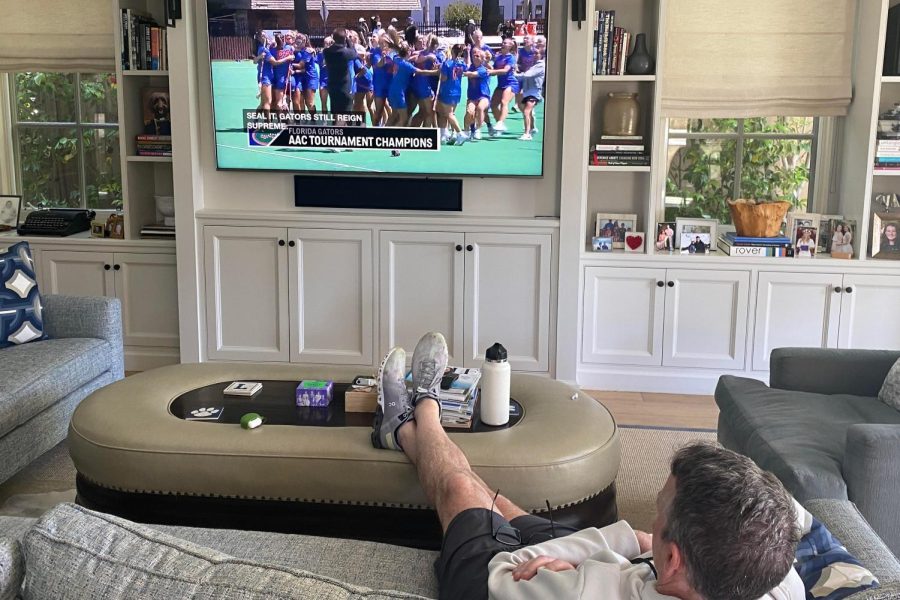Op-Ed: Dear readers, please watch women’s sports
Photo credit: Claire Doyle
My dad sits down and watches a women’s lacrosse game in our living room. Streaming women’s sports in homes is important to create a society that validates female athletes’ hard work.
May 23, 2023
Standing on the sidelines of my brother’s high school lacrosse games, I see pom poms, senior posters and professional camera equipment. I see monogrammed Louis Vuitton bags with their school logo. I never got these things at my girls’ lacrosse games. The problem here is a difference in the investment of time, energy and money into boys’ versus girls’ sports.
“Be the change you want to see in the world”: a phrase coined by activist Mahatma Gandhi. Though not meant to describe women’s sports, I feel it fits the dilemma: women’s sports need more recognition, and people need to take action. If women’s sports were broadcasted to a wider audience, more people would understand why female athletes deserve a seat at the table.
We need to be aware of our implicit bias formed by strictly watching men’s sports. When people ask me, “Who is your favorite athlete?” I immediately jump to Tom Brady or Kobe Bryant instead of female athletes such as Charlotte North and Alex Morgan. As a society, we have been conditioned to respect men’s sports more than women’s sports, taking women out of the equation.
However, there has been a recent shift in the public viewership of women’s sports. The 2023 women’s NCAA basketball tournament hit an all-time high viewership of 5.5 million viewers, a 72% increase in viewership from last year. Alongside this achievement, the NCAA men’s basketball tournament hit an all-time low viewership of 14.7 million viewers.
This popularity is accredited to the rivalry between University of Iowa player Caitlin Clark and Louisiana State University player Angle Reese. The back-and-forth comments and hype videos previously posted on TikTok made the game more exciting and brought in a larger audience.
When I was watching the women’s lacrosse NCAA championships this year, my brother started talking about North, saying, “Isn’t she the best in the country?” It took me a second to process the fact that my brother was actually asking me about a women’s lacrosse player. I asked him how he knew her, and he only responded, “Who doesn’t?”
I was suddenly hit with a feeling of appreciation. I don’t know if it was due to a male actually acknowledging the accomplishments of a female lacrosse player or someone aside from my teammates actually knowing who North is.
It’s not the people, it’s the system. I try to remember this when people don’t acknowledge female athletes or their hard work. It’s not their fault for not being exposed to women’s sports when our society puts men’s sports on a pedestal. When restaurants and sports bars only play men’s sports, we are given two options: bow to the system or awkwardly stream a women’s game on our phones while everyone around is cheering at the men’s game.
This is where restaurants such as The Sports Bra in Portland, Oregon, become a necessity to communities. The Sports Bra plays strictly women’s sports on TV and is decorated in a plethora of women’s sports jerseys, trophies and photos of sports icons. Exposure to women’s sports is key to bringing women into the conversation. This exposure starts in every household, restaurants and major streaming services.
Supporting women does not mean ignoring men. Bring female athletes into the conversation, and athletics will become more inclusive, diverse and entreating.



















